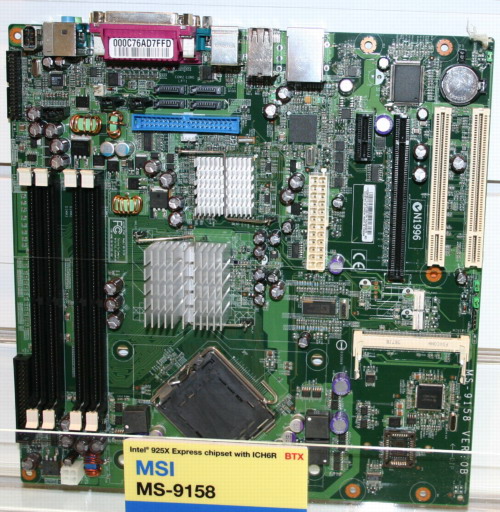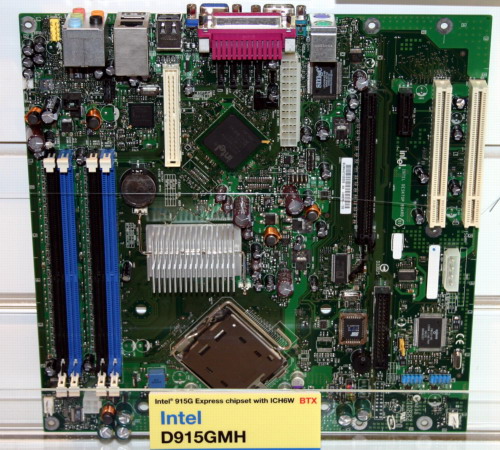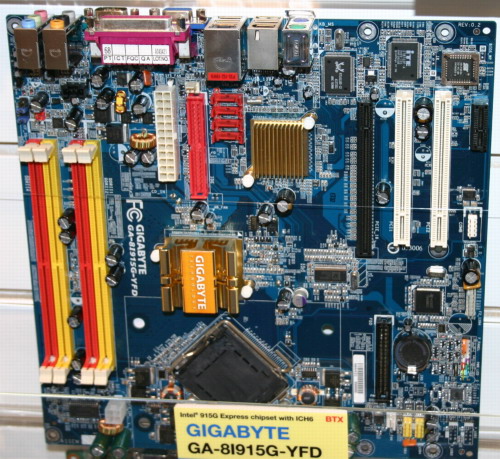Computex 2004: BTX at the Show
by Anand Lal Shimpi on June 2, 2004 7:17 AM EST- Posted in
- Trade Shows
BTX Motherboards Galore
You'll remember from our BTX article that there are three flavors of BTX: pico, micro and regular BTX. Most of the motherboards we saw were micro BTX, meaning they had four expansion slots and are about the size of a micro ATX motherboard.
Of course, Intel's micro BTX motherboard was present at the Intel showcase:
The Intel board features the newly announced 915 chipset, and features two PCI Express slots and two 32-bit PCI slots. One of the more noticeable changes BTX offers is that the graphics card slot (PCI Express x16) is now the last slot (or the first depending on how you look at it) on the board, making cooling much easier and much less restrictive.
It may be difficult to see in this picture, but note that the four SATA ports are located directly behind the parallel port at the top of the picture. It's sort of ironic to put one of the latest interface standards directly behind one of the oldest and most cumbersome.
It was good to see boards from companies like Gigabyte present as well, after all what use is an industry standard if Intel is the only one to demonstrate it?
Gigabyte's board is also a micro BTX, indicated by its four expansion slots. Gigabyte's slot layout is a bit different from Intel's, as are their SATA and BTX power connectors. Considering where the SATA cables will end up, Intel's orientation of the connectors may make more sense and require less twisting of the already fragile SATA connectors to install properly.
MSI's board was also a departure from Intel's design, and we believe it also violates the BTX spec (or at least one of its goals). Can you see the problem?

Look carefully at the expansion slots, the PCI Express x16 slot isn't the first slot on the board, there's an x1 slot that comes before it - defeating one of the cooling purposes of BTX. To MSI's credit, this is most likely a very early motherboard sample without much care or attention paid to such details, but this could also be one reason why more BTX motherboards haven't been shown off - a lack of spec compliance.
MSI's solution was 925X based, which is the first 925X based BTX motherboard that we've seen thus far.












28 Comments
View All Comments
epiv - Friday, June 4, 2004 - link
What is wrong with AnandTech? With all the new stuff at Computex. The first article has to be about a new standard that is not very exciting. I am not impressed with the BTX products offered right now. I am sure there are other more interesting products in Computex.justly - Friday, June 4, 2004 - link
#23 – I did see that only micro and pico BTX boards where the only ones referenced in the article but unless Anand made a mistake in the article (very possible) it does state that “Chenbro had a full BTX tower on display”. If you look at that case guess what you find, only 4 slots, again this may be an error in the article but that is why I mentioned it. The thing is if micro BTX is about the same size as micro ATX adding more expansion slots to a micro BTX should result in the same size increase as adding more to Micro ATX. Simple logic dictates that if two micro size boards are “about the same size” and adding expansion slots increases both by the same amount then they will end up being about the same size, so it would appear the claim that they are smaller is not accurate.As for moving the CPU to the front, well all I can say is welcome back BAT with ATX features, anything more would end up in a rant about Intel.
Madcat - Thursday, June 3, 2004 - link
Now that I've had a chance to see a few examples of the BTX format, I like the idea of more outside airflow over the cpu, but I don't like the idea of buying a lot of other new parts.The way I see it is that there is a lot of flexibility in the ATX format but very limited in BTX as far as placement of motherboard components. I don't think the enthusiast motherboard makers will like that, but OEM type would.
By looking at the designs I don't see why Intel wanted to develop a whole new format when they could have stuck with a ATX one. There are a lot of current solutions out there that bring in outside air directly to the cpu that would work just fine. I can imagine a few routing options that could be included with new cases to route fresh air from the front and still stay in an ATX format, without having to much of an impact on airflow.
I also don't like the fact that the case would open on the opposite side. My main PC sits on my desk and I like that I can get to the side panel without having to pull the case completely out of the mini-cubbyhole in the shelf system that is part of my desk to turn it around. In order to make it easy to access it I'd have to buy a whole new left oriented facing shelf versus my right oriented one. No thanks to that extra cost.
If they really felt that a change was needed they really should have gone with standards hashed out by industry leaders as a group instead of going it alone like they did with rambus.
Personally I don't see the format sticking, since they are abondoning the P4 platform to go with the far better and cooler running pentium M core which they are developing for the desktop. I do see it as best for the OEM crowd. I do like the idea just not how it morphed into a completely different format.
#13 - I agree. WTF was Intel thinking by not providing a transitory chipset? So my $450 9800XT is useless if I want the latest and greatest P4 tech? Ugh....
However...as to no AGP slot on the 9xx chipset boards, that's apparently baloney. ECS is making a board that implements both AGP AND PCI-E. =) Not sure how they enabled it, but from what I've read it performs pretty well. I hope the other makers can do that as well.
bupkus - Thursday, June 3, 2004 - link
Since I'm a fan of AMD who's memory traces are at odds with BTX, I reject Intel's arrogant unilateral push. However, if I were ever to purchase Intel at a client's insistance, I would consider BTX. For my own use though I agree with #16 about Shuttle as now my best option for reduced size and gaming portability.mkruer - Thursday, June 3, 2004 - link
BTX is all based upon the assumption that the air in front of the pc is cooler then the back. I also like Lian-Li case idea. Move the PSU to the bottom, and move the motherboard to the top. I would say then next thing to do is to pull air directly in from the back, and exhaust out the top, so the air come right in then out for the CPU. As for the other peripheral, a nice slow rotating 120mm fan should be more then sufficient for the entire case.Xentropy - Thursday, June 3, 2004 - link
#21 - "Did you notice that BTX only has as many upgrade slots as micro ATX?"Actually that's because the only BTX boards produced/displayed so far are microBTX and picoBTX. There IS a "full-sized" BTX standard that will have the same number of slots as a full ATX motherboard. Anand's previous article on BTX (several months ago) mentioned the three sizes in the standard.
http://www.anandtech.com/showdoc.html?i=1876&p...
The fact there aren't any full BTX boards is the main reason I won't be going BTX this go around. Hopefully some are available by next year. Mind that while a full BTX board is the same size as a full ATX board, the case around it can be made smaller due to a need for less fans and a lower ambient temperature. Think of a Lian-Li PC30 w/o the cooling issues. Small, light case but which can easily handle a full-sized motherboard.
As for the turbulance issue, I see the biggest change in BTX as moving the CPU to the front of the case, not moving the ATA connections. PATA routing is important, but SATA connectors can be just about anywhere without issue, and BTX is a future standard which assumes SATA. If ATX motherboards start placing the CPU at the front center where a direct path of fresh outside air can flow over FIRST the CPU then the video card and then out the back, well, they'd basically have a BTX board there.
bhtooefr - Thursday, June 3, 2004 - link
"Although these aren't BTX based, Intel showed off some set top box form factor solutions running ultra low voltage P4s and i815E chipsets"WHAT? The i815E is for Socket 370 chips - the Mendocino, Coppermine, and Tualatin Celerons, the Pentium III, and the VIA C3.
Also, if you look at the photo of the set top MSI box, it says ULV Celeron up to 700 or 750MHz (I couldn't tell).
justly - Thursday, June 3, 2004 - link
19, Did you notice that BTX only has as many upgrade slots as micro ATX, or this statement in the article "Most of the motherboards we saw were micro BTX, meaning they had four expansion slots and are about the size of a micro ATX motherboard". So as for it being smaller I would say that is only marginally true (and at the expense of expansion slots and drive bays).Also, most turbulence is going to be caused by to many (improperly placed) fans, not the difference between case designs. If anything BTX may reduce dead air zones, and even that is mostly due to one change in board design (moving the PATA connection to the top, behind the drive bays). Then again good routing of PATA ribbon cables or the use of round PATA or SATA cables pretty much take care of that problem.
As far as I am concerned there isn’t enough of a (well actually any) benefit to BTX that warrants switching from ATX. On second thought there might be one good thing about BTX, case manufactures seem to have very little flexibility in their design so it might reduce the amount of poorly designed cases and just leave people with a poorly designed standard to go by :)
epiv - Thursday, June 3, 2004 - link
ATX only have been around for about 10 years.Xentropy - Thursday, June 3, 2004 - link
#16-"BTX has no relavence to going smaller and quieter..."What? Have you read anything about BTX besides the Inquirer's FUD?
From this article:
"Smaller form factors (although not as small as the ones championed by Shuttle), cooler internals and quieter overall systems are all benefits that cannot be ignored."
By creating a more direct path for airflow, turbulence is lowered, resulting in lower noise. More efficient use of the air also allows for lower CFM fans, which of equal quality will mean lower noise as well.
At any rate, I've been using Lian-Li cases for several years now, and they ARE in fact wonderful cases, but certain improvements would require some rearrangement of components on the motherboard to effect. Workarounds like air ducts can be installed in ATX cases to bring cool air directly to the CPU, for example, but that wouldn't be as efficient as just putting the CPU at the front of the case directly in front of the intake fans.
So I guess I still don't understand. Why all the opposition? No one's being forced to buy BTX, and ATX will still be around for years to come, especially if AMD never makes the switch due to the memory trace issues. Since Intel and AMD systems obviously already require different motherboards, using different form factors as well wouldn't be much of an issue. I don't know a whole lot of people who'd take an AMD system out of a case and build an Intel system in the same one, or vice-versa. Generally they'd buy a new case for the new system so they can use or sell the old system as a complete package.
Most of the outrage seems to be over the price of a new case, but I guess I don't agree with most people's assessment that BTX will suddenly 100% phase out ATX overnight and thus require everyone buy a new case the next time they build a system.